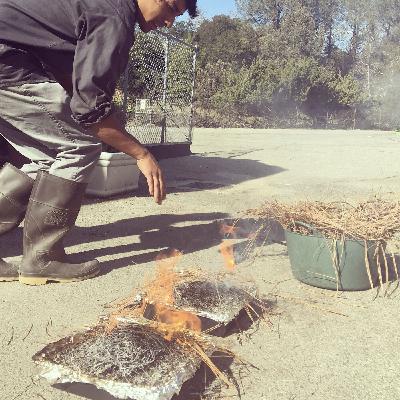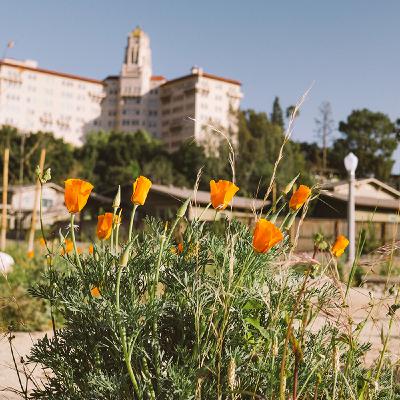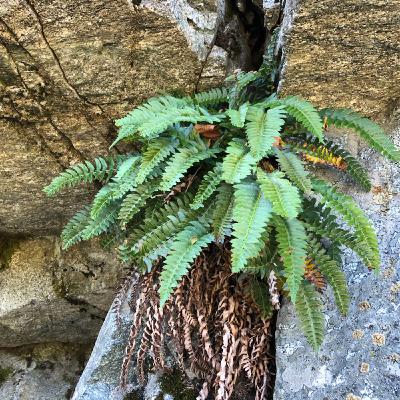Discover Forever California
Forever California

Forever California
Author: California Botanic Garden
Subscribed: 31Played: 140Subscribe
Share
© 2023 California Botanic Garden
Description
From the tiniest poppy to the tallest redwood, we're sharing stories on California native plants and the wildlife and people who love them. This is Forever California, the official podcast of California Botanic Garden. Here at California Botanic Garden, we conserve and celebrate the native plants that make our state so special. California is one special place. We are a biodiversity hotspot, a region of astounding botanical treasures, with over 6,000 native species. Over 1/3 of these plants are endemic, found nowhere else on the planet.California native plants are beautiful in a garden, invaluable in our ecosystems, vital in California Native American culture and are amazing organisms with so much to tell us. This podcast endeavors to take you on a botanical journey through our amazing flora, connecting along the way with the fauna that depend on our native plants and the people who conserve, grow and cherish them. We hope this podcast helps bring the Garden and the remarkable world of California native plants to you.
9 Episodes
Reverse
#BlackBotanistsWeek, a campaign first organized in July 2020 to "promote, encourage, create a safe space for, and find more Black people (and BIPOC) who love plants!," sparked a nation-wide dialogue on the vital and ongoing need to make the plant sciences more inclusive, accessible and diverse. Black people (and BIPOC) have faced systemic racism in related professions, in addition to plaguing discrimination that haunts people of color outdoors and in the field - such as the incident that happened to Audubon Board Member Christian Cooper in New York's Central Park. On this episode of Forever California, we hand the mic to Naomi Fraga, PhD, Director of Conservation Programs at California Botanic Garden, as she stewards a panel discussion on diversity in the plant sciences. Joining Naomi are scientists, activists, professors and community leaders who share their experiences discovering botany and moving the needle forward for inclusion in the field. Panelists include:Tanisha Williams, PhD: one of the founders of #BlackBotanistsWeek and a Postdoctoral Researcher Bucknell UniversityAnn Sakai, PhD: Professor, University of California, IrvineMuriel Poston, PhD: Professor of Environmental Analysis, Pitzer College Joel Abraham, PhD: Associate Professor, California State University FullertonPanelists speak about their careers and experiences in the plant sciences, sharing inspiration and pathways to elevate others interested in plants and the larger natural world.California Botanic Garden sincerely thanks everyone involved in the production of this episode; both for their generosity in sharing their stories, as well as for making the plant sciences a better community for all through lifetimes of commitment, courage and compassion. Here are some additional links to programs created to diversify and advance plant sciences and related STEM or museum fields: BSA PLANTS ProgramESA SEEDSDoris Duke Conservation Scholars Program Ford Foundation FellowshipGetty Marrow Undergraduate Internship Ronald E. McNair Post-baccalaureate Achievement ProgramSACNASSupport the show
Seeds are incredible. Every towering coast redwood, every ancient oak tree, every golden poppy among millions in a superbloom began life as a seed. Within each seed is a blueprint for a plant’s entire life and the energy to kickstart that plant's unfolding story. In addition, seeds are imbued with an amazing array of adaptations - a bag of botanical tricks - to start life at just the right moment. True masochists, many seeds live by the mantra “no pain, no gain.” To trigger germination, some seeds need to be scraped up as they fall down a cliff; others need to be put through fire; some prefer to be eaten alive and others beg for frostbite-inducing temperatures. When the magic combination takes place: eureka! the seed sprouts (germinates) and a new plant emerges.California Botanic Garden is home to the California Seed Bank, the largest collection of seeds that are stored to safeguard the future for native plants. We have banked conservation seed collections of roughly one-third of all species native to California. We endeavor to collect seeds from every species to ensure the survival of our invaluable and absolutely irreplaceable flora. Part of the job of Cheryl Birker, Seed Conservation Program Manager, is to conduct germination trials to test the viability of seeds in storage. To do this, she has to figure out that perfect recipe, the perfect trick, to trigger plants to grow.On this episode, we’ll learn about these germination trials and techniques - from smoke water to “disturbance” - that Cheryl has implemented to get seeds growing as well as the fundamental purpose and incredible work that goes on at the California Seed Bank at California Botanic Garden.Support the show (https://11213.blackbaudhosting.com/11213/Garden-Fund-General-Donations)
Squirrels are one of the most animated and assured kinds of wildlife visitors will encounter here at California Botanic Garden. These fluffy, scruffy and nutty denizens love our California native plants. There are actually three species that reside here - the western gray squirrel, ground squirrel and eastern fox squirrel. Of the three, the fox squirrel is invasive, a species that was brought to Southern California by human means. Its presence here brings up questions about the future of our western gray squirrels in the garden, as fox squirrels have been displacing and extricating our native tree squirrel here in the LA basin. On this episode, we talk with squirrel expert and Professor Emeritus of Biological Sciences of Cal State LA, Alan Muchlinski. Alan has been researching the impacts of fox squirrels on our native western gray squirrels for decades and has spent the past 11 years studying the populations of these two squirrel species at the Garden. He has discovered some interesting relationships and surprising correlations about our resident squirrels. Tune in to hear more about this epic saga of the most squirrelly nature. Support the show (https://11213.blackbaudhosting.com/11213/Garden-Fund-General-Donations)
There are many species of native butterflies in California. These winged gems, symbols of beauty, depend on California native plants for survival. We call this the butterfly connection!We are unfortunately unable to open our beloved Butterfly Pavilion this year, an exhibit that showcases native butterflies and their favorite host and nectar plants, but we are excited to share the wonders of these remarkable organisms with you virtually. Join us in conversation with Butterfly Pavilion volunteer and Professor Emeritus of Biology of Cal Poly Pomona Steve Bryant and Butterly Specialist, Marion McGinnis, as we discuss native butterfly species and how to attract and raise them! Whether you have a big backyard or a balcony, you can cultivate plants that support and draw in these gorgeous creatures. From the iconic monarchs to dazzling tiger swallowtails, California dogfaces to the masses of painted ladies, California is abounding with butterflies. But these important pollinators could use many more native plants as further habitat is disturbed and developed. Give them a hand (or host or nectar plant) and support our local butterflies! Support the show (https://11213.blackbaudhosting.com/11213/Garden-Fund-General-Donations)
A hidden lake, a sky island, an incredibly rare plant: these may sound like the makings of a fantasy novel, but they are parts of an amazing conservation success story. Hidden Lake bluecurls (Trichostema austromontanum ssp. compactum) live only along the shoreline of Mt San Jacinto's only lake, one that appears and disappears like a mirage depending upon annual precipitation. This adorable plant — tiny, aromatic and purple-flowered — was once considered so threatened that it was federally listed. Thanks to the remarkable work of California Botanic Garden's Conservation Programs, California State Parks and US Fish and Wildlife Service, this species has been successfully delisted because of important protective measures and field research conducted by these agencies. In this episode we hear from our Director of Conservation, Naomi Fraga, PhD, about the different conservation programs she oversees at the Garden and the saga of the Hidden Lake bluecurls!Support the show
April 11-19 is Native Plant Week! We are celebrating a bit differently during these challenging times by taking a moment each day to appreciate the fabulous native plants that live right next door. On this week's episode, Native Plants Next Door, we're partnering with the fabulous California Native Plant Society to discuss the local plants that live in our communities and the actions we can take to care for these botanical neighbors. Across California, our communities are associated with distinctive native plants - plants that provide vital resources for the wildlife that depend on and love them. In our neighborhoods, native plants are often right in front of our eyes, right under - or over! - our noses. From the stately coast live oak on the street corner, to a flourish of wildflowers in a roadway median, to the chaparral that brushes up against the backyard. For many of us, our home gardens also contribute native plant neighbors. Whether in small or large patches, these native plants contribute to improve environmental quality for all of us and are intrinsic to what makes California, California.This Native Plant Week, please consider supporting our mission to safeguard, research and showcase the native plants next door. Your contribution will help our native plant neighbors flourish as California Botanic Garden works at the forefront of native plant research, conservation, horticulture and public engagement.DonateSupport the show (https://11213.blackbaudhosting.com/11213/Garden-Fund-General-Donations)
The majority of ferns used in California landscapes are non-native and water-loving; low-water-use alternatives are rarely available. We're working to introduce five native, low-water-use fern species to the nursery trade that are uniquely adapted to California's Mediterranean climate. Join us in conversation with Ashlee Armstrong, CalBG's Grounds Manager and leader of the Chaparral Fern Project supported by the Saratoga Horticultural Research Endowment. We'll discuss this multi-year project that has taken Ashlee and fellow staff out into the wilds of Southern California to collect these marvelous chaparral ferns and established them in test plots at CalBG. Ashlee will share progress on our horticultural trials aimed at testing the viability of chaparral ferns in the home landscape.Lucinda McDade, Executive Director, will shed light on the ecology of these chaparral ferns including how they interact (or not) with herbivores.Support the show
California native plants are the perfect choice for home gardeners in California! They can be exquisitely beautiful, are often quintessentially water-wise, support a vibrant web of life and speak to an aesthetic unique to California. In today's episode, we're going to learn some foolproof native plants to consider in your home garden or landscape. In conversation with Peter Evans, Director of Horticulture at California Botanic Garden, we'll discuss some hardy species and cultivars to consider that can handle brown thumbs while looking absolutely beautiful. We'll also ask members of our Horticulture team about what plants they've found to be fairly indestructible and garden-friendly in their experience cultivating California natives. Whether you're contemplating adding your first California native plant to your garden or have already converted your entire yard, we hope these insights and ideas provide you with some inspiration to get planting! So much so that we hope you'll browse our Grow Native Nursery's new ecommerce website and purchase some fabulous native plants. During these challenging times, as our society and community grapple with Coronavirus (COVID-19), we're glad to provide access to our native plant inventory for pickup orders. Please visit for california-botanic-garden.myshopify.com for information about placing an order and to make your online purchase! Support the show (https://11213.blackbaudhosting.com/11213/Garden-Fund-General-Donations)
On our very first episode, we are taking flight, well nearly with Lo & Behold. That's his full name, but we tend to call him Lo, or little owl. Lo is a ridiculously cute great horned owlet who has quite an owldessy. He has fallen out of his nest not once, but twice, and to keep things light in these very challenging times, I'm going to fastforward and say he is safe now and cuddled up with mom in a Cadillac of owl's nests. Thanks to the amazing work and intervention of my colleagues at California Botanic Garden, Lo has been routinely rescued and expertly placed back in increasingly fool-proof nests. You might be wondering why our California native plant podcast is branching out today on the topic of owls; our native plants provide excellent habitat for birds of prey and excellent habitat for the rodents that they eat. So today we'll be talking with Lisa Pritchard and Ming Posa, our resident owl rescuers and California Botanic Garden staff members who have been secondary parents to little Lo. They check on him everyday and Mom seems to appreciate their incredible help. We'll also talk to Tina Stoner, President of the Pomona Valley Audubon Society on local birds of prey and ways to appreciate and help them in our community. Finally, we'll meet up with Bob Everett, CEO of Wild Wings of California and discuss bird rehabilitation. Make a landing at Pomona Valley Audubon Society's site at www.pomonavalleyaudubon.org!Fly over to Wild Wings of California's site at www.wildwings.org. RATS, or Raptors are the Solution (www.raptorsarethesolution.org), is a great resource for learning the measures you can take to safeguard birds of prey in your community. No more rodenticide! Support the show (https://11213.blackbaudhosting.com/11213/Garden-Fund-General-Donations)













What is that rare plant found in Oxnard lot?